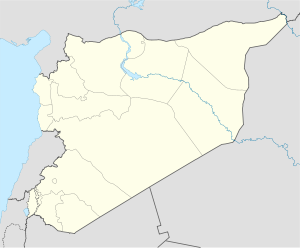- Maarat al-Numaan
-
Ma'arrat an-Nu'man
معرة النعمان
Maarat al-NumaanGreat Mosque of Ma`arrat an-Nu`man Location in Syria Coordinates: 35°38′N 36°40′E / 35.633°N 36.667°E Country  Syria
SyriaGovernorate Idlib Governorate District Ma`arrat al-Numan District Elevation 530 m (1,739 ft) Population (2010)[1] – Total 90,000 Maarat al-Numaan, Arabic: مَعَرَّة النُّعْمَان , is a city in northwestern Syria with a population of about 90000 (year 2010).[1] It is located at the highway between Aleppo and Hama and near the Dead Cities of Bara and Serjilla. The city, known as Arra to the Greeks and Marre to the Crusaders, has its present-day name combined of the traditional name and of its first Muslim governor an-Nu'man ibn Bashir, a companion of Muhammad.
Today the city has a museum with mosaics from the Dead Cities, the Great Mosque of Maarrat al-Numan, a madrassa built by Abu al-Farawis from 1199 and remains of the medieval citadel. The city is also a birthplace of the poet Abu al-Ala al-Maari (973 - 1057).
The town was the focus of intense protests against the regime of President Bashir Al-Assad with a number of people killed on 2 June 2011.
Contents
Massacre of Ma'arra
Main article: Siege of Ma'arraThe most infamous event from the city's history dates from late 1098, during the First Crusade. After the Crusaders, led by Raymond de Saint Gilles and Bohemond of Taranto, successfully besieged Antioch they found themselves with insufficient supplies of food. Their raids on the surrounding countryside during the winter months did not help the situation. By December 12 when they reached Ma`arra, many of them were suffering from starvation and malnutrition. They managed to breach the city's walls and massacred about 8000 inhabitants. However, this time, as they could not find enough food, they resorted to cannibalism.[2]
One of the crusader commanders wrote to Pope Urban II: "A terrible famine racked the army in Ma`arra, and placed it in the cruel necessity of feeding itself upon the bodies of the Saracens.[2]
Radulph of Caen, another chronicler, wrote: "In Ma`arra our troops boiled pagan adults in cooking-pots; they impaled children on spits and devoured them grilled."[2]
These events were also chronicled by Fulcher of Chartres, who wrote: "I shudder to tell that many of our people, harassed by the madness of excessive hunger, cut pieces from the buttocks of the Saracens already dead there, which they cooked, but when it was not yet roasted enough by the fire, they devoured it with savage mouth."[3]
Among the European records of the incident was the French poem 'The Leaguer of Antioch', which contains such lines as,
- Then came to him the King Tafur, and with him fifty score
- Of men-at-arms, not one of them but hunger gnawed him sore.
- Thou holy Hermit, counsel us, and help us at our need;
- Help, for God's grace, these starving men with wherewithal to feed.'
- But Peter answered, 'Out, ye drones, a helpless pack that cry,
- While all unburied round about the slaughtered Paynim lie.
- A dainty dish is Paynim flesh, with salt and roasting due.
- From "The Leaguer of Antioch"[4]
Those events had a strong impact on the local inhabitants of Southwest Asia. The crusaders already had a reputation for cruelty and barbarism towards Muslims, Jews and even local Christians, Catholic and Orthodox alike. (the Crusades began shortly after the Great Schism of 1054).[citation needed]
See also
- Great Mosque of Maarrat al-Numan
References
- ^ a b Population Statistics for the Cities of Syria at BevoelkerungsStatistik.de
- ^ a b c Amin Maalouf, The Crusades Through Arab Eyes, trans. Jon Rothschild (News York: Schocken Books, 1984), 39.
- ^ Edward Peters, The First Crusade: The Chronicle of Fulcher of Chartres and Other Source Materials (University of Pennsylvania Press, 1998), 84.
- ^ Von Sybel; History and Literature of the Crusades; translated by Lady Duff Gordon
External links
- The Cannibals of Ma`arra at Utah Indymedia
- Encyclopedia of the Orient
- [1]
Further reading
- Amin Maalouf, The Crusades Through Arab Eyes. Schocken, 1989, ISBN 0-8052-0898-4
Coordinates: 35°38′19″N 36°40′18″E / 35.63861°N 36.67167°E
Idlib Governorate Cities 

Towns and villages Armanaz · Al-Bawabiya · Binnish · Kafr Nabl · Khan Shaykhun · Ma'arrat Misrin · Mardikh · Qunaya · Salqin · Saraqib · SarminCategories:- Crusades
- Populated places in Idlib Governorate
Wikimedia Foundation. 2010.



